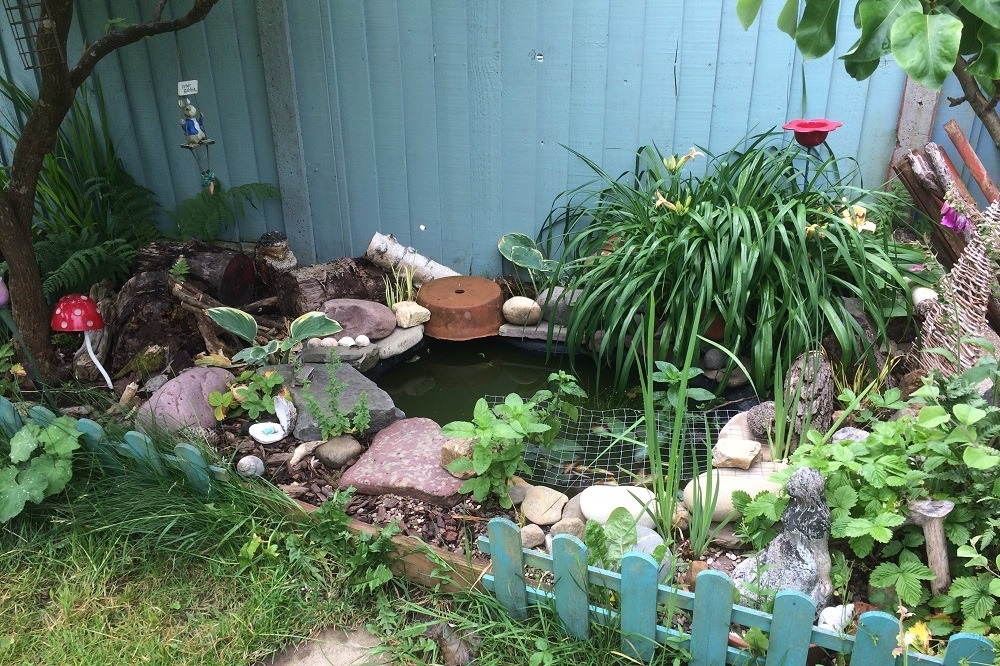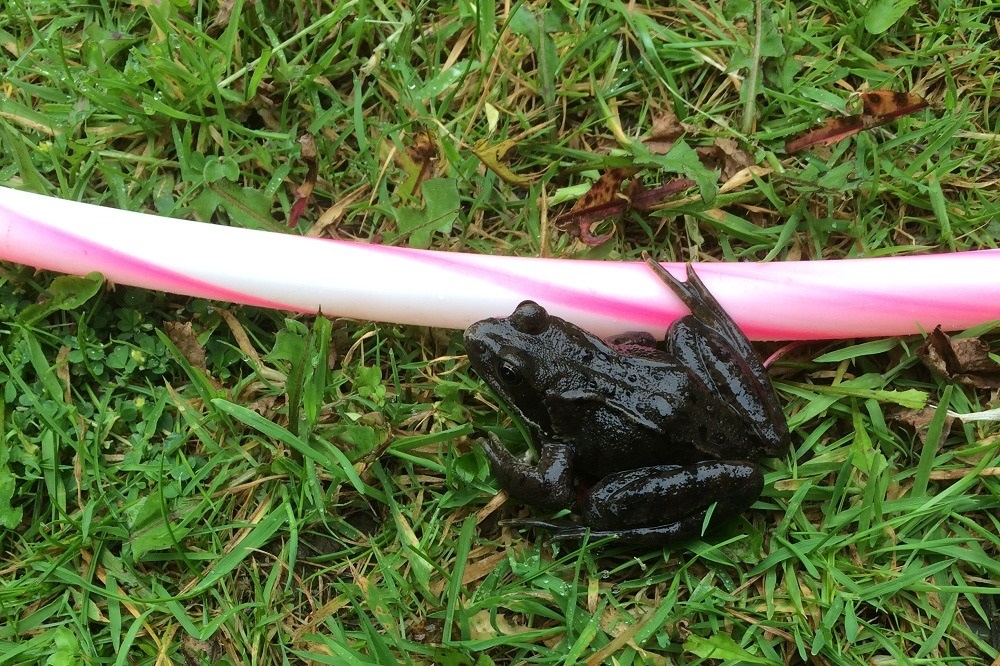Tawny Clark: For the love of ponds

Tawny Clark
In our everything-on-demand culture we expect immediate results. Impatience has become our factory setting. With the long-term reward of tree planting being somewhat anti-climactic, we need something else capable of firing up our brain’s endorphin-boosting, instant reward centres while we wait.
Good news. There’s a surprising high roller in town. Packing an impressive punch, with near-instant gratification – the humble garden pond. Yes, you heard; digging a pond is the perfect way to combat those covid and climate-blues.
Regardless of size, material, location, time of year, you’re almost guaranteed to benefit wildlife by creating a pond.
There’s a long list of ideal factors to consider (Google them), but honestly, it’s one of the easiest and most rewarding additions you can bring to your garden. Not only do they provide habitat for beneficial invertebrates, but they also support amphibians which prey on slugs and snails, and can benefit birds, reptiles, and mammals too.
With the loss of over 70% of the UK’s ponds in the last hundred years, the populations of species depending on these landscape features have drastically declined. It’s ludicrous when you start discovering just how wonderous ponds truly are.
Armed with a plan, enthusiastic home-schooling workforce (at the start of the day at least), shovels, and wellies, the dig commenced. This was March 2020 – Lockdown Week 1. The eager start soon turned to distraction, boredom, and inevitably hunger, but within the day we’d completed the grunt work.

Rainwater is best
While plastic isn’t the ideal pond-making medium, as an affordable, straightforward option for a child-friendly project we used a preformed mould with varied depths and little steps up the side.
Obviously, water safety must be considered but for young children there are endless hours of excitement, wonder, and a whole host of positive emotions to be gained from a pond, and it can be as simple as burying a bucket (with an escape ramp/stick and a sunken up-ended brick). Suggesting a friend try this, she was amazed to discover two bathing frogs in her bucket-pond only weeks later.
At roughly one hundred litres, and less than a square metre, our pond was hardly a nature reserve, but this new addition fitted unobtrusively into a corner like it was meant to be.
Rainwater is best. With the wet winter, we had a full waterbutt and assortment of neglected containers brimming with delicious pond juice. In no time at all our tiny waterbody was full and our clothing soaked. And then patience. The advice is always to wait; amphibians will find their way.
However, with every hour in lockdown dragging interminably on and the impossible pressures of enforced home-schooling, impatience took hold. I did something I shouldn’t. During our permitted daily exercise window, I took tadpoles from a waterbody nearby. A common practice in bygone days, moving amphibians risks spreading fatal diseases like Ranavirus and Chytridiomycosis, and is ill-advised.
Not to justify my actions, but the ephemeral waterbody dried up only weeks later during the lockdown heatwave. My dozen pilfered tadpoles now the only survivors.
Unexpected sanctuary
With a study finding 100% mortality in 50% of waterbodies surveyed it’s a worrying outlook when you think there are 70% fewer ponds to start with. With 50% of each dwindling generation failing, there’s no better time for the seven out of eight UK households fortunate enough to have a garden, to get busy digging.
When we set out, my thoughts were on the practical activity, something to wear out the kids and keep my mind off the terrifying, toxic mist of the pandemic. With any luck we’d enhance the wildlife in the space we were now confined to for twenty-three hours a day as well.
However, what our tiny pond became was an unexpected sanctuary during those difficult times, not just for wildlife but for ourselves. It connected us to nature’s calendar and brought with it endless surprises, laughter, and excitement as we watched the cycle of life in real time.
It wasn’t without drama. I hurled myself screaming down the garden when a magpie snatched one of our twelve tiny tadpoles from the water and cried when I discovered another shrivelled up on a sun-baked edging stone.
That first spring, the fate of our precarious colony balanced on a knife-edge. Every casualty was a bitter blow, but every minute froglet that metamorphosised onto land felt a major triumph.
I tried to remain upbeat, but I knew the odds were stacked against them. Frogs supposedly eat slugs, but when you observe a pea-sized froglet sitting jockey-like atop an enormous slime giant there’s a need for fantasy narrative and the perilous optimism of a hero’s journey. That summer, as covid accelerated, I clung to hope – for our army of froglets, for our loved ones and for ourselves.
While we created hibernaculum around the garden out of sticks, stones, and old flowerpots, froglet spotting became our autumnal happy place. Over winter we waited.

Positive impact
I knew there was a resident frog in our garden already, but, being confined by fences and walls I hoped the pond would enable our population to expand over time – in 2-3 years once our froglets matured. As it turned out, there must have been two.
Noticing an eruption of green gunge in the pond in February 2021, I feared something terrible had occurred. I began fishing out the strange bloom of…hang on…that’s frogspawn, covered in algae.
A football-sized clump of jellied eggs, right there in our pond! Unbelievable. No doubt the animated shrieking drew raised brows from neighbours as I rushed to rally the family round the pond. A truly magical day.
I knew wildlife supposedly arrives quickly to new ponds, but you don’t believe it until you see it, do you? The appearance of a sky-blue damselfly in June 2021 was another delightful surprise. It was a moment that made me realise just what a positive impact even the smallest of waterbodies could have. Imagine what a whole network of these across all our gardens could achieve.
The garden soundtrack of summer 2021 consisted of frequent, exuberant squeals as the playing children disturbed the profusion of developing froglets and sent them springing like clockwork toys in all directions across the unmown lawn.
But the real highlight – by far the greatest shock of all – was the female palmate newt that rocked up in August 2021. To avoid disappointment, I’d driven any thoughts of newts firmly from my mind, so I was frankly dumbfounded by this newest arrival, and rather emotional to say the least.
For such a tiny pond, a fun little project to distract us from bigger worldly worries, to become such a thoroughly rewarding and whole-heartedly enriching experience has surpassed any expectation I had.
I’m so excited to see what this year brings for our pond, but of course, now, what I really want is a bigger one, and for everyone else to share in the joy and fulfilment which comes with creating a pond of their own.
Support our Nation today
For the price of a cup of coffee a month you can help us create an independent, not-for-profit, national news service for the people of Wales, by the people of Wales.






Great article!!!!